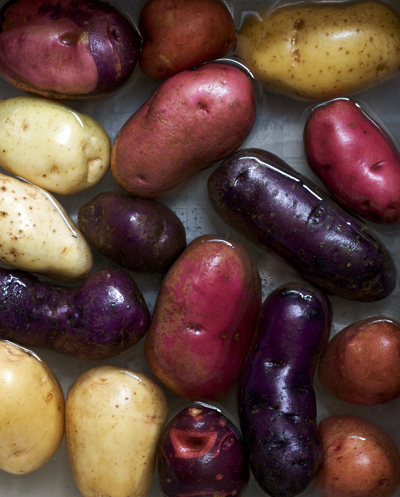Forget spuds, try La Pomme De Terre Gourmande
Gourmet potatoes continue to increase in popularity, first finding their way into upscale restaurants and farmers markets and now into mainline grocery stores.
Fingerlings, crescents, blue-skin, blue-flesh, red-skin, red-flesh, red eyes, purple eyes, yellow flesh with purple eyes. I could keep going, but I think I’ve made my point. Potatoes just don’t come in round whites, round reds and russets anymore. Changing eating habits and market demand has helped fuel the increase in their popularity.
|
Potatoes genetically have a wide range of shapes, sizes and colors, but the U.S. consumer has previously desired a smooth skinned, white fleshed potato. Sunken eyes make them difficult to peel and nobody wanted skin flecks in their mashed potatoes. However, once restaurants started serving roasted garlic, mashed potatoes that weren’t completely peeled, all of a sudden skin flecks were okay. Once one barrier is removed, removing the second is often easier.
We humans are complicated beings – on one hand we resist change, but on the other hand marketers find we like it. How many times have you seen a box in the grocery store with writing on the outside indicating the box has changed, but reassures us the contents are the same (“Same great ingredients, only the box has changed!”)? That is kind of what happens with potatoes and other food items. Once we get accustomed to something, we start thinking, “Do these come in different colors, shapes and sizes?” This type of thinking is prevalent in people who make a career out of paying attention to food and reminding us to pay attention to it (Martha Stewart, Rachel Ray, Rick Bayless).
Production inputs of gourmet potatoes are no different than other types of potatoes and growers with the right market outlets should consider their production. Yields may be a bit lower, but providing you have the market, returns can be 400 percent greater than regular potatoes. These returns are often realized in direct market sales or to high end restaurants. If your marketing strategy includes either of these outlets, you should consider producing these potatoes at least on a small scale to evaluate how they will sell.
To help make your decision on which ones to grow, Michigan State University will be conducting an evaluation trial of 30-plus gourmet varieties in 2012 at the Southwest Michigan Research and Extension Center near Benton Harbor, Mich. (see map and directions). Entries will include several fingerling and crescent-types as well as blues, reds and other colors. Look for results to come out sometime this fall.



 Print
Print Email
Email


